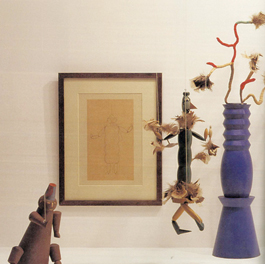home | metro silicon valley index | the arts | books | review

Sophie Taeuber-Arp
Designer, Dancer, Architect
By Michael S. Gant
Some of the most insouciant images of Dada in the moment of creation are the photographs of the avant-garde cabaret shows mounted at Cabaret Voltaire and Galerie Dada in Zürich. These antic and anarchistic evenings jumbled up music, abstract dance, poetry and cheeky costumes into one-of-a-kind provocations. Hugo Ball, Tristan Tzara and Hans Arp get most of the credit; this catalog of a Swiss design exhibit gives equal weight to a remarkable woman and leading light of the movement. Swiss artist Sophie Taeuber, born in 1889, became Hans Arp's partner around 1915 and eventually married him in 1922; in 1918, she was one of the signers of the famous Dada Manifesto. A student of Rudolf von Laban, "the father of free dance," Taeuber-Arp created cutting-edge theatrical spectacles for Dada soirees, donning strange, boxy masks designed by her husband and dancing with stylized movements to Hugo Ball's sound-poems. One of the photos in the book shows Taeuber-Arp gleefully posing in a cheeky Dada outfit of breastplates and pope's hat made from what looks like corrugated cardboard. Of her style, Ball wrote, "Every gesture is articulated a hundred-fold, sharp, light, pointed." A prolific designer in a variety of fields, Taeuber-Arp also worked as a journalist, graphic designer and architect. With the modernist Swiss Marionette Theater, she conjured up 17 marvelous wooden puppets for a fairy tale called König Hirsch. Six full-page plates display her wonderful witty creatures, assembled from geometrical wooden forms, cleverly jointed and strung together. Tufts of feathers decorate the vaguely human characters; a pair of stags boast scimitar-shaped golden horns. One elongated orange sprite is named Freud Analytikus—among other things, the play parodied the new field of psychoanalysis. An accomplished sculptor, Taeuber-Arp also made "Dada heads," smooth, ovoid shapes brightly painted and sporting coiled-wire features; only one example, strangely, is illustrated. As part of the Swiss arts and crafts movement known as Das Neue Leben, Taeuber-Arp designed carpets, lamps (in shapes resembling her marionettes) and "austerely cubic" furniture. One of the essays (which are printed in both German and English) uncovers overlooked evidence that Taeuber-Arp was also an important and visionary architect. (By Museum Bellerive; Scheidegger & Spiess/Univ. of Chicago Press; 72 pages; $30 hardback)
Send a letter to the editor about this story.
|
|
|
|
|
|